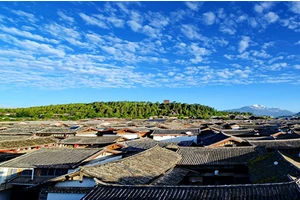Petra tourism
Petra's geographical location is full of mystery and uniqueness, and the only way to enter is through a narrow gorge. The widest part of this canyon is about 7 meters, and the narrowest part can only allow one carriage to pass, with a total length of about 1.5 kilometers. Once in the canyon, the tunnel twists and turns, steep and deep, and the road surface is covered with pebbles. The rocks on the cliff have become smooth under the long-term action of wind and rain, just like being cut by a knife and axe. Looking up at the sky along the cliff, I saw a glimmer of blue sky, which was spectacular and beautiful, hence the name "a glimmer of sky".
In 1812, the Swiss explorer John Burckhardt discovered Petra. He is proficient in Arabic, dressed as a Muslim, and persuaded a local guide to offer a goat in front of a tomb (it is said that there is a buried city near the tomb). The guide took Burckhardt along Sikh, the only road for tourists, a narrow crack deep in rocks. When they walked along the narrow and hidden Sikh, they suddenly saw the front of the treasure house under the sunshine. This experience is amazing at any time.
Petra's geographical location and mysterious discovery reflect the courage and wisdom of human beings to explore the unknown world. John Burckhardt's courage and wisdom not only discovered this hidden ancient city, but also left a valuable cultural heritage for future generations. This ancient city not only shows the exquisite skills of ancient architecture, but also reveals the prosperity and glory of ancient civilization. Petra's geographical location and its mysterious discovery have become the treasures of the world cultural heritage, which has aroused great interest in its history and culture.
Extended data
Petra is an ancient city in Jordan, located 250 kilometers south of Amman, Jordan, hidden in a narrow canyon connecting the Dead Sea and the Aqaba Strait. In ancient times, it was an important trade center and the capital of Erdom. Many historical sites have been discovered since 1812, most of which are carved on the rock wall of a deep valley. It is one of the key cities in Jordan's tourism industry.
William, a famous British poet? Bergen once wrote two lines: "What shocked me was only the land of the East, and the rose red wall witnessed the whole history." This is a hymn for a place called Petra. Archaeologists once commented on Petra: "This is a first-class archaeological site, the largest archaeological treasure in the Middle East." What the hell is Petra? Why is it so worthy of attention and praise?
No matter from which angle, Petra is a place worth introducing. The city has been floating and sinking in the historical changes, and then mysteriously disappeared. Up to now, it has hardly been touched.
From the 2nd century to the 3rd century, that is, the heyday of the Roman Empire, Petra was once a leader in the eastern provincial capital of Rome, but it declined for a long time. In the 19th century, it became a city with extremely mysterious geographical location, hidden in the gorge between the Dead Sea and Akbar Bay (today's Jordan), and was called "Petra Ruins" by Arabs, and few people from outside visited this place.
Although driven by curiosity, some people tried to enter Petra, but often they could not find the specific geographical location or were unfortunately killed by local pagans. Because the only way to Petra is a gorge about 61 meters deep, this is the "Hall Fortress" mentioned in the Bible. In 1812, a Swiss named Beckhart finally entered this long-forgotten city.
All the way through the gruesome Hall fortress, Beckhart found the most amazing building in the world: a statue carved entirely from solid rock, 40 meters high and 31 meters wide, with decorated columns bigger than a real person. Under the sunshine, it showed bright pink, red, orange and crimson, with vivid layers and elegance. Because the whole building is carved in the sand stone wall and lined with yellow, white and purple stripes, it is amazing! This is the famous Kazini stone carving.
After passing Kazini and marching along the canyon, Beckhart found that there is a city hidden here: surrounded by cliffs and cliffs, forming a natural wall; Two fractures in the wall form a natural passage in and out of this narrow valley. There are more buildings carved on the surrounding mountain walls. Some are very simple and can only be regarded as caves; Others are large and exquisite, with terraces, statues, magnificent entrances and multi-storey pillar porches. All this is carved on red and pink rock walls.
Petra Discovered in Beckhart Based on years of research and study, Beckhart speculated that these buildings are the tombs and temples of the vanished Nabatai people. Nabatai people regard the late kings as gods, their tombs as temples, and it is their custom to dig cemeteries in rocks.
Nabatai people are Arab nomads, who moved northward from Arabian Peninsula into the region (in present-day Jordan and South Syria) in the 6th century BC. They built many settlements here and made Petra the capital, because it has typical strategic advantages: the only entrance is a narrow gorge, which can be described as and while one man guards it and ten thousand cannot force it; There are also rich resources and environment: abundant water resources, lush forests and fertile pastures.
Moreover, Petra is located near the main trade routes from Asia and Arabia to Europe. Businessmen from all over the world escort camels loaded with goods through here, transporting Arab spices, Indian spices imported through the Persian Gulf, Egyptian gold and China silk to markets in Damascus, Tyre and Gaza. In the 4th century BC, it became an important commercial city. In the 2nd century BC, Nabateda reached its heyday, and its territory extended from Damascus to the Red Sea. Nabatai characters have gradually evolved into contemporary Arabic characters, which are widely used in most of the Arab world today. From 80 BC to 65 BC, during the reign of King Altas II, the Nabataeans minted their own coins and built a Greek amphitheater. The city of Petra was famous in the ancient world. No matter where, even as far away as China, as long as there are camel caravans and trade groups, people have heard of the mythical stone city-Petra.
In 106 A.D., the Romans captured Petra, and the city and its surrounding area became a province of the Roman Empire, known as the Petra region of Arabs. It was the most prosperous province in the Roman Empire. Roman engineers paved commercial roads and improved irrigation facilities. The economic benefits created by Petra in recent years accounted for a quarter of the economic production income of the Roman Empire.
However, Petra's trade began to change: more and more goods were transported by sea, and a city named Alexandria on the Mediterranean coast took part of its business; Land transportation also began to change. The Romans built a road in the north of it, connecting Damascus in Syria with Mesopotamia (today's Iraq) and plundering more transportation trade. By the 2nd century, Petra's economic strength and wealth were greatly weakened. In the 3rd century, Petra became a part of the Eastern Roman Empire and became a Christian city, where the Archbishop of Byzantium lived. In the 4th century, with the resurgence of Islam in the Arab region, the Arab Petra region became a small province of the Islamic Empire.
At this time, Petra was almost abandoned. Centuries later, Petra, a stone city, once flourished again because it was used as a military fortress during the Crusades. But in the 7th century, Petra was abandoned again. Before Beckhart's visit, the western world completely forgot about it, and the cemetery here was only used by nomads as a shelter from the wind and rain.
Beckhart wrote what he saw and heard in Petra into a book called A Journey to the Syrian Holy Land. The beautiful description in the book aroused the passion of Europeans to explore this place. In 1835, a well-read American tourist, John, was only 30 years old. Li jode? Stephens (who later discovered the Mayan city of Copon in the jungles of South America) came to this almost disappeared city. Like Beckhart, Stephens was shocked by the beautiful scenery of Kazini that suddenly appeared in front of him. However, after the baptism of history, these buildings were unrecognizable at that time.
After returning to new york, Stephens published the book "Travels of the Arab Petra" in 1837. He described the Kazini stone carving like this: "A temple, exquisite and clear, is like a relief gem embedded in a rock wall." After the book was published, it won the praise of American poetry critic Ellen? Poe's high evaluation and praise, and became a best seller in the United States and Britain. Poet William? For this reason, Bergen wrote a poem Petra, and the haunting poem made him immortal. Steven, a 20th century filmmaker? Spielberg felt people's attention to Petra and filmed the film Indiana? Jones and the Last Crusade once again made Petra famous in a completely different artistic way. With Petra becoming a tourist attraction, archaeologists from all over the world have come here to investigate and explore.
Petra has become a famous tourist destination. If the research in the past years has focused on those cemeteries, today's archaeologists are more and more interested in Petra's lifestyle. Archaeological researchers found that Nabatai people not only engaged in trade, but also made and exported exquisite pottery-their clay vessels were thin and exquisite, decorated with natural patterns such as branches and leaves. Perhaps many of their masterpieces are buried in the ruins of Petra, waiting for future generations to explore.
In the 1990s, Petra unearthed part of the wall and the whole floor of the Byzantine church under the rule of the Eastern Roman Empire, as well as a set of parchment scrolls of about 40 volumes. Scientists estimate that they have a history of more than 1,400 years, dating back to the late Roman era.
Why was Petra abandoned? Even if it loses control of the commercial road, it can still survive, so why didn't it survive? Archaeologists have analyzed that the decline of Petra may be caused by natural disasters. In 365 AD, an earthquake hit the city of Petra. After the earthquake, many buildings were in ruins. In 551 AD, the city of Petra suffered another serious earthquake, which may have collapsed the Byzantine church. Then the church was attacked by a fire that spread all over the city after the earthquake, and the parchment scroll that recorded the history of the city was destroyed in the fire. The city also began to decline and disappear.
But why can many cities be rebuilt after earthquakes and fires, but Petra can't? Scientists believe that environmental deterioration is one of the factors leading to Petra's decline. They have studied a large number of Petra's burial sites and found that in the early Nabataean era, forests were all over the mountains around Petra. However, in Roman times, a large number of forests disappeared. People cut down a lot of wood for building houses and getting fuel, and herded sheep too much, which made forests and grasslands disappear slowly, and this area gradually became a desert.
No matter what kind of speculation, Petra is like a book that has only been read for a few pages. No matter where you go in Petra, you will face some mysteries. We expect more amazing discoveries in this ancient and ever-changing city!






